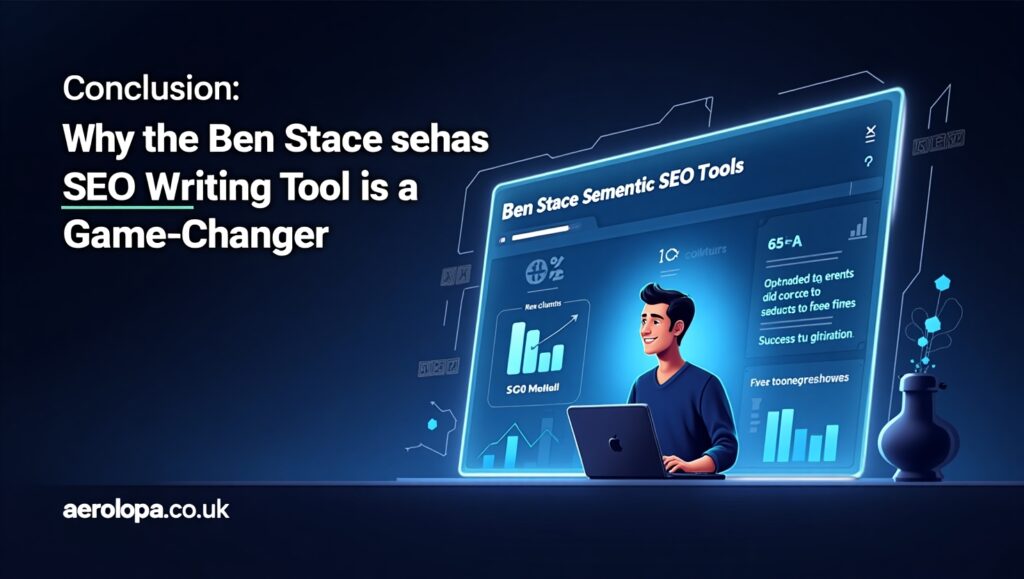In the ever-evolving world of search engine optimization (SEO), staying ahead requires tools that align with modern algorithms and user expectations. The Ben Stace Semantic SEO Writing Tool has emerged as a game-changer, helping businesses, marketers, and content creators craft content that ranks higher, resonates with audiences, and builds lasting authority. Unlike traditional keyword-focused tools, this AI-powered platform emphasizes semantic relevance, user intent, and topical authority, making it a must-have for anyone serious about SEO in 2025. This comprehensive guide explores the tool’s features, benefits, and strategies for optimizing content using semantic SEO, Answer Engine Optimization (AEO), Google’s E-E-A-T principles, and more.
What is Ben Stace’s Semantic SEO Writing Tool?

The Ben Stace Semantic SEO Writing Tool is a cutting-edge artificial intelligence (AI) tool designed to create content that is compatible with Google’s complicated algorithms, such as RankBrain, MUM, and BERT. Developed by Ben Stace, a renowned semantic SEO expert from Melbourne, Australia, this tool moves beyond outdated keyword-stuffing tactics to focus on context, intent, and entity-based optimization. It helps users craft content that not only ranks well but also establishes topical authority and enhances user engagement.
Key Features of the Tool
- Entity Recognition: Identifies and incorporates relevant entities (people, places, concepts) to align with Google’s Knowledge Graph.
- Topical Cluster Generation: Creates structured content maps with pillar pages and supporting cluster articles for comprehensive topic coverage.
- Search Intent Analysis: Analyzes top-ranking competitors to align content with informational, navigational, or transactional intent.
- Internal Linking Recommendations: Suggests strategic internal links to build a semantically rich content network.
- Real-Time Content Feedback: Provides suggestions for sentence structure, tone, readability, and semantic keyword placement.
- Structured Data Integration: Recommends JSON-LD schema markup to enhance search engine understanding and SERP visibility.
By leveraging Natural Language Processing (NLP) and AI, the tool ensures content is both user-friendly and algorithm-friendly, making it ideal for SEO, AEO, and establishing E-E-A-T (Experience, Expertise, Authoritativeness, Trustworthiness).
Why Semantic SEO Matters in 2025
Instead of depending only on keyword density, semantic SEO optimizes content according to meaning, context, and user purpose. Google’s algorithms have evolved to prioritize content that answers user queries comprehensively, understands relationships between entities, and delivers value. The Ben Stace Semantic SEO Writing Tool is designed to meet these demands by helping users create content that aligns with modern search engine priorities.
The Shift from Keywords to Context
In order to rank higher, traditional SEO concentrated on repeating target keywords. However, updates like Google’s Hummingbird, BERT, and MUM have shifted the focus to:
- User Intent: Understanding whether a query is informational (“what is semantic SEO?”), navigational (searching for a specific site), or transactional (intent to purchase).
- Entity-Based Optimization: Recognizing real-world objects or concepts (e.g., “coffee machines” or “digital marketing”) and their relationships.
- Topical Authority: Establishing a website as a go-to resource by covering a topic comprehensively through pillar and cluster content.
The Ben Stace tool excels in these areas, enabling users to create content that speaks the language of both users and search engines.
How the Ben Stace Semantic SEO Writing Tool Works
The tool’s workflow is designed to simplify the complexities of semantic SEO while delivering measurable results. Here’s an intensive description of how it works.
1. Keyword and Topic Research
The tool begins by analyzing a core keyword or topic (e.g., “roof repair Dallas”). It scans the top 20 search results to extract semantic terms, secondary keywords, and related entities. This ensures content covers all relevant subtopics and aligns with user intent.
2. Topical Map Creation
Ben Stace is known as a topical map expert, and his tool reflects this expertise. It generates a visual map of core topics and subtopics, creating a hierarchy that search engines love. For example:
- Pillar Page: “The Ultimate Guide to Roof Repair”
- Cluster Pages: “Common Roof Repair Issues,” “Cost of Roof Repair in Dallas,” “How to Choose a Roofing Contractor”
This structure signals topical authority and improves crawlability.
3. Content Optimization
The tool provides real-time suggestions for:
- Semantic Keywords: Synonyms, related terms, and phrases to enhance relevance.
- Readability: Ensuring content is engaging and easy to read for humans.
- Entity Integration: Naturally weaving in entities like locations, brands, or concepts.
- Intent Alignment: Tailoring content to match the user’s query type (informational, transactional, etc.).
4. Structured Data and Internal Linking
The tool recommends JSON-LD schema markup (e.g., FAQ schema, product schema) to boost SERP visibility and suggests internal links to create a robust content network. This allows both seek engine comprehension and person navigation.
5. Performance Tracking
The tool integrates with platforms like Google Search Console to monitor metrics like organic traffic, click-through rates, and engagement. This allows users to refine content based on real-world performance.
Benefits of Using the Ben Stace Semantic SEO Writing Tool
The tool has been credited with transformative results across industries, from e-commerce to local businesses. Here are some key benefits, supported by real-world examples:
- Increased Organic Traffic: A health and wellness site saw a 187% increase in organic traffic in 90 days by using the tool to create entity-optimized content.
- Improved Rankings: An e-commerce brand jumped to the top 3 results for 22 commercial keywords after rewriting product descriptions with the tool.
- Reduced Bounce Rates: A SaaS company reduced its bounce rate by 30% by aligning content with user intent.
- Featured Snippet Success: The tool’s structured data recommendations helped clients secure featured snippets and People Also Ask (PAA) placements.
- Enhanced E-E-A-T: By focusing on expertise, authority, and trustworthiness, the tool helps brands build trust with both users and Google.
These results highlight the tool’s ability to deliver sustainable, long-term SEO success.
Optimizing for AEO (Answer Engine Optimization)
In addition to SEO, the Ben Stace tool is designed for Answer Engine Optimization (AEO), which focuses on providing direct, concise answers to user queries for voice search and featured snippets. The tool:
- Identifies common questions related to a topic using NLP.
- Recommends question-answer formats for FAQ schema.
- Optimizes content for voice search queries like “What is the best roofing contractor in Dallas?”
This ensures content is ready for Google’s “People Also Ask” boxes and voice assistants like Siri or Alexa.
Incorporating E-E-A-T Principles
Google’s E-E-A-T framework (Experience, Expertise, Authoritativeness, Trustworthiness) is critical for ranking in competitive niches. The Ben Stace tool helps users meet these standards by:
- Experience: Encouraging first-hand insights and practical examples in content.
- Expertise: Recommending content depth and entity-based optimization to showcase knowledge.
- Authoritativeness: Suggesting links to authoritative sources (e.g., Wikipedia, official brand pages).
- Trustworthiness: Ensuring content is accurate, transparent, and backed by credible data.
For example, a local dental practice used the tool to create entity-rich content and FAQ schema, resulting in a 123% increase in organic traffic for geo-specific queries like “dentist near me.”
Geo-Specific Optimization for Local SEO
For businesses targeting local markets, the Ben Stace tool excels at geo-specific optimization. It:
- Identifies location-based entities (e.g., “Dallas roofing services”).
- Recommends localized content clusters (e.g., “Roof Repair Costs in Texas”).
- Integrates schema markup for local business listings.
A home services company in Austin, TX, used the tool to target semantic variants of “HVAC repair services,” achieving a 123% traffic increase in three months.
A way to Use the Ben Stace Semantic search engine optimization Writing device for Pillar content material
Pillar content is the cornerstone of a semantic search engine optimization strategy, serving as a comprehensive useful resource that covers a broad subject matter extensive.
Step 1: Identify Core Topics
Conduct a content material audit to pinpoint your niche’s number one issues. For example, a fitness e-commerce brand might choose “Protein Supplements” as a core topic.
Step 2: Build a Pillar Page
Create a long-form guide (e.g., “The Ultimate Guide to Protein Supplements”) that covers the topic comprehensively. The tool suggests subtopics like “Whey vs. Casein,” “Benefits of Plant-Based Protein,” and “How to Choose a Protein Powder.”
Step 3: Develop Cluster Content
Write supporting articles that dive deeper into subtopics. Hyperlink those cluster pages back to the pillar web page to create a content network. The tool’s internal linking recommendations ensure a logical structure.
Step 4: Add Structured Data
Use the tool’s schema markup suggestions to enhance visibility. For example, add product schema for e-commerce or FAQ schema for informational content.
Step 5: Monitor and Refine
Song overall performance metrics and use the device’s feedback to update content, ensuring it remains applicable and authoritative.
A SaaS company followed this approach for “cloud storage,” creating a pillar page and cluster articles on pricing, integrations, and security. The result? A 42% traffic increase in six months.
Who Should Use the Ben Stace Semantic SEO Writing Tool?
The device is flexible and benefits a extensive variety of customers:
- SEO Agencies: Scale content production with semantically optimized articles.
- Affiliate Marketers: Dominate niche SERPs with long-form, intent-driven content.
- E-commerce Stores: Enhance product descriptions and category pages with entity-rich content.
- Local Businesses: Target geo-specific queries to outrank competitors.
- B2B Marketers: Build thought leadership and trust through topical authority.
Getting began with the Ben Stace Semantic search engine optimization Writing device
To leverage the tool effectively:
- Sign Up: Access the tool through platforms like Boostrankify or NJ Marketings, which integrate Ben Stace’s technology.
- Input Your Goals: Enter your target keyword, niche, or business objectives.
- Follow the Workflow: Use the tool’s suggestions to create a topical map, write content, and implement structured data.
- Track Results: Monitor traffic, rankings, and engagement to refine your strategy.
For more information, visit Ben Stace’s official website or connect via LinkedIn for consulting opportunities.
Conclusion: Why the Ben Stace Semantic SEO Writing Tool Is a Game-Changer

The Ben Stace Semantic SEO Writing Tool is more than just a content creation platform—it’s a strategic partner for navigating the complexities of modern SEO. By focusing on semantic relevance, user intent, and topical authority, it empowers users to create content that ranks higher, engages audiences, and builds trust. Whether you’re optimizing for SEO, AEO, E-E-A-T, or local search, this tool provides the framework and insights needed to succeed in 2025 and beyond.
Ready to transform your content strategy? Embrace the power of semantic SEO with the Ben Stace Semantic SEO Writing Tool and start building a digital presence that dominates search results.




